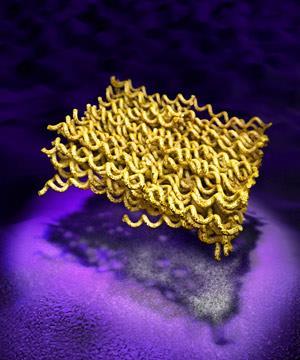Noodle-like nanostructures emerge as a cheap alternative to graphene

By simply heating sugar and salt, researchers in Germany have made a new, and seemingly flat, form of carbon.1 The material shows extraordinary potential for energy storage and electrocatalysis applications.
Nina Fechler from the Max Planck Institute of Colloids and Interfaces and colleagues isolated the puzzling sheet-like material with a constant thickness a few years ago. Unexpectedly the sheets also had a very high surface area (up to 3200m2/g), exceeding a hypothetical single layer graphene material (around 2600m2/g), and showed microporosity at the same time. In addition, it contained many more heteroatoms than could possibly be accommodated within graphene planes, as well as electrochemical characteristics ahead of most ordinary graphene materials.2
Driven by their curiosity to understand how one material could accommodate all of these properties, the team used advanced TEM techniques to elucidate its structure. It turns out the material comprises interlinked carbon nanoribbons knitted into homogeneous layers and looks rather like a block of uncooked ramen noodles.
‘It’s a new type of carbon morphology that resembles graphene but is not graphene. It’s doped with nitrogen or sulfur, which are known to increase catalytic activity. The carbon noodle bands are terminated with one of these active molecules and are very accessible, making them potentially much better for any application that graphene is used for at the moment,’ explains Fechler. Changing the salts changes the heteroatoms; providing a route to tune the material’s properties.
Liming Dai, an expert in carbon nanotechnology at Case Western Reserve University in Cleveland, US, congratulates the researchers on making a material with such a large surface area. ‘The heteroatoms doped along the edges can work as active centres for electrocatalysis, meaning the sheet is kept undamaged, improving conductivity,’ he adds.
Graphene is a sheet material and due to attraction, the sheets stick together, becoming an inflexible block of carbon with no free space between the layers. Fechler’s carbon material, however, has lot of interstitial space so is ready to use, without further modification.
‘I find this knitted structure quite intriguing,’ comments Lennart Bergström, a materials chemist at Stockholm University in Sweden. ‘This very simple way of production using molten salts and sugar gives a very valuable material.’
Fechler says the material ‘would be perfect for an electrode’ and could replace graphene in several applications.
References
1 X Liu et al, Mater. Horiz., 2016, DOI: 10.1039/c5mh00274e This article is open access
2 K Elumeeva et al, CHEMELECTROCHEM, 2015, 2, 584 (DOI: 10.1002/celc.201402364)












No comments yet